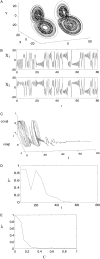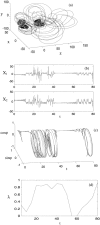Nonlinear phase desynchronization in human electroencephalographic data
- PMID: 11835608
- PMCID: PMC6871870
- DOI: 10.1002/hbm.10011
Nonlinear phase desynchronization in human electroencephalographic data
Abstract
Ensembles of coupled nonlinear systems represent natural candidates for the modeling of brain dynamics. The objective of this study is to examine the complex signal produced by coupled chaotic attractors, to discuss their potential relevance to distributed processes in the brain, and to illustrate a method of detecting their contribution to human EEG morphology. Two measures of quantifying the behavior of coupled nonlinear systems are presented: a measure of phase synchrony and a novel measure of intermittent phase desynchronization. These are used to quantify the behavior of numerical examples of coupled chaotic attractors. Experimental evidence of their contribution to the morphology of the human alpha rhythm is then illustrated in a study of EEG recordings from 40 healthy human subjects. Amplitude-adjusted phase-randomized surrogate data is used to test the null hypothesis that the observed patterns of phase coherence can be described by purely linear methods. Statistical analysis reveals that this null hypothesis can be robustly rejected in a small number (approximately 4%) of EEG epochs. These findings are discussed with reference to the adaptive function and complex dynamics of the brain.
Copyright 2002 Wiley-Liss, Inc.
Figures
















References
-
- Achermann P, Borbely A (1998): Coherence analysis of the human sleep electroencephalogram. Neuroscience 85: 1195–1208. - PubMed
-
- Afraimovich V, Verichev N, Rabinovich M (1986): Stochastic synchronization of oscillation in dissipative systems. Radiophys Quantum Electron 29: 795.
-
- Ashwin P, Covas E, Tavakol R (1999): Transverse instability for non‐normal parameters. Nonlinearity 12: 563–577.
-
- Basar E (1980): Chaos in brain function. Springer‐Verlag: London.
-
- Boiten F, Sergeant J, Geuze R (1992): Event‐related desynchronization: the effects of energetic and computational demands. Electroencephalogr Clin Neurophysiol 82: 302–309. - PubMed
Publication types
MeSH terms
LinkOut - more resources
Full Text Sources

